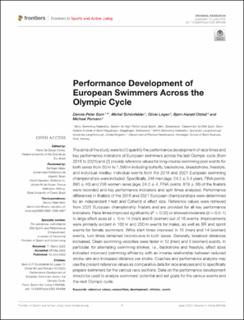| dc.contributor.author | Born, Dennis-Peter | |
| dc.contributor.author | Schönfelder, Michel | |
| dc.contributor.author | Logan, Oliver | |
| dc.contributor.author | Olstad, Bjørn Harald | |
| dc.contributor.author | Romann, Michael | |
| dc.date.accessioned | 2022-12-01T12:17:23Z | |
| dc.date.available | 2022-12-01T12:17:23Z | |
| dc.date.created | 2022-08-30T11:13:37Z | |
| dc.date.issued | 2022 | |
| dc.identifier.citation | Frontiers in Sports and Active Living. 2022, 4, Artikkel 894066. | en_US |
| dc.identifier.issn | 2624-9367 | |
| dc.identifier.uri | https://hdl.handle.net/11250/3035338 | |
| dc.description | This is an open-access article distributed under the terms of the Creative Commons Attribution License (CC BY). The use, distribution or reproduction in other forums is permitted, provided the original author(s) and the copyright owner(s) are credited and that the original publication in this journal is cited, in accordance with accepted academic practice. No use, distribution or reproduction is permitted which does not comply with these terms. | en_US |
| dc.description.abstract | The aims of the study were to (1) quantify the performance development of race times and key performance indicators of European swimmers across the last Olympic cycle (from 2016 to 2021) and (2) provide reference values for long-course swimming pool events for both sexes from 50 m to 1,500 m including butterfly, backstroke, breaststroke, freestyle, and individual medley. Individual events from the 2016 and 2021 European swimming championships were included. Specifically, 246 men (age: 24.2 ± 3.4 years, FINA points: 890 ± 40) and 256 women races (age: 24.2 ± 4, FINA points: 879 ± 38) of the finalists were recorded and key performance indicators and split times analyzed. Performance differences in finalists of the 2016 and 2021 European championships were determined by an independent t-test and Cohen's d effect size. Reference values were retrieved from 2021 European championship finalists and are provided for all key performance indicators. Race times improved significantly (P < 0.05) or showed moderate (d = 0.5–1) to large effect sizes (d > 1) in 14 (men) and 6 (women) out of 16 events. Improvements were primarily evident in 100 m and 200 m events for males, as well as BR and sprint events for female swimmers. While start times improved in 15 (men) and 14 (women) events, turn times remained inconclusive in both sexes. Generally, breakout distances increased. Clean swimming velocities were faster in 12 (men) and 5 (women) events. In particular, for alternating swimming strokes, i.e., backstroke and freestyle, effect sizes indicated improved swimming efficiency with an inverse relationship between reduced stroke rate and increased distance per stroke. Coaches and performance analysts may use the present reference values as comparative data for race analyses and to specifically prepare swimmers for the various race sections. Data on the performance development should be used to analyze swimmers' potential and set goals for the various events and the next Olympic cycle. | en_US |
| dc.language.iso | eng | en_US |
| dc.subject | athletes | en_US |
| dc.subject | competition | en_US |
| dc.subject | development | en_US |
| dc.subject | reference values | en_US |
| dc.subject | sports | en_US |
| dc.title | Performance development of European swimmers across the Olympic cycle | en_US |
| dc.type | Peer reviewed | en_US |
| dc.type | Journal article | en_US |
| dc.description.version | publishedVersion | en_US |
| dc.rights.holder | © 2022 Born, Schönfelder, Logan, Olstad and Romann | en_US |
| dc.source.pagenumber | 10 | en_US |
| dc.source.volume | 4 | en_US |
| dc.source.journal | Frontiers in Sports and Active Living | en_US |
| dc.identifier.doi | 10.3389/fspor.2022.894066 | |
| dc.identifier.cristin | 2047106 | |
| dc.description.localcode | Institutt for fysisk prestasjonsevne / Department of Physical Performance | en_US |
| dc.source.articlenumber | 894066 | en_US |
| cristin.ispublished | true | |
| cristin.fulltext | original | |
| cristin.qualitycode | 1 | |
